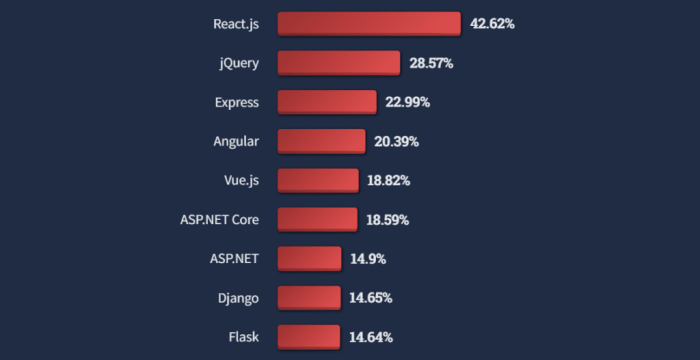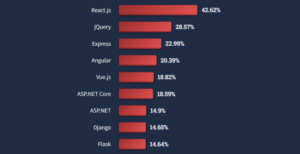
Web development using React vs Vue invites you into a dynamic discussion about two leading frameworks that have transformed the landscape of web application development. Each framework brings unique strengths to the table, making them popular choices among developers. Whether you’re diving into your first project or exploring new options, understanding the nuances of React and Vue can help you make informed decisions on the best tools for your needs.
From performance metrics and learning curves to community support and integration practices, this exploration highlights the main features that distinguish React from Vue, helping you navigate the vibrant ecosystems that surround these technologies.
Comparison of React and Vue
Both React and Vue have gained significant popularity in the web development landscape, each offering unique advantages that cater to different project requirements and developer preferences. By comparing their performance metrics, learning curves, and distinguishing features, developers can make informed decisions about which framework to adopt for their projects.
Performance Metrics
Performance is a critical factor in web development, impacting user experience and site efficiency. Both React and Vue utilize a virtual DOM to optimize rendering processes, but their implementations differ.
- React employs a reconciliation algorithm that efficiently updates the UI by only rendering components that have changed. This approach can lead to superior performance in applications with numerous state changes, especially when correctly leveraging its memoization features such as `React.memo` and hooks like `useMemo`.
- Vue, on the other hand, utilizes a dependency tracking system that allows it to only re-render components when their respective data properties change. It’s particularly effective for applications with dynamic data and offers impressive performance out of the box, often leading to faster initial rendering times compared to React.
In benchmarking scenarios, both frameworks demonstrate strong performance, but the choice between them may depend on specific use cases and how well the developer can optimize the application.
Learning Curve
Understanding the learning curve of each framework is crucial for new developers, as it influences the speed at which they can become productive.
- React has a steeper learning curve primarily due to its JavaScript-centric approach, requiring familiarity with concepts like JSX, component lifecycle methods, and hooks. Developers need to grasp functional programming concepts to utilize React effectively, which can be challenging for those transitioning from traditional object-oriented programming backgrounds.
- Vue is often regarded as more beginner-friendly. Its template syntax is straightforward, resembling HTML, which makes it easier for newcomers to grasp. Vue’s comprehensive documentation and clear design principles facilitate a smoother onboarding process. Moreover, its reactivity system simplifies state management, allowing developers to build applications without extensive boilerplate code.
While both frameworks offer robust ecosystems, Vue’s accessibility can make it a preferable choice for those just entering the world of web development.
Main Features Distinguishing React from Vue
React and Vue have distinct features that make them suitable for different development scenarios. Understanding these differences can help developers choose the right tool for their specific needs.
Component-Based Architecture
Both frameworks are built around components, but React’s approach emphasizes a functional programming paradigm, promoting the use of hooks for state and lifecycle management. Vue, in contrast, provides a more flexible architecture that allows developers to choose between options API and composition API, catering to different coding styles.
Ecosystem and Tooling
React’s ecosystem is extensive, with a variety of libraries and tools like Redux for state management and React Router for routing. This can sometimes lead to complexity in choosing the right tools. Vue, however, comes with a more opinionated package of tools, including Vue Router and Vuex, which can simplify development.
Community and Support
Both frameworks boast strong communities and support systems, but React’s larger community often means more tutorials, resources, and third-party libraries available for developers. Vue, while smaller, maintains a dedicated community that produces high-quality plugins and extensions.
“A framework’s choice should align with project requirements and team expertise, as both React and Vue offer unique strengths to enhance web applications.”
Community and Ecosystem Support

The community and ecosystem surrounding a framework play a crucial role in its adoption and usability. Both React and Vue enjoy strong community backing, but the nature and impact of this support vary significantly between the two. Understanding these differences can help developers choose the right framework for their projects.
Community Size and Engagement
React boasts one of the largest developer communities in the world, attributed to its backing by Facebook and its extensive use in enterprise-level applications. This vibrant ecosystem leads to a wealth of shared knowledge and resources. Developers can find a plethora of forums, discussion groups, and meetups dedicated to React, fostering collaboration and support. In contrast, Vue’s community, while smaller, is known for its inclusivity and enthusiasm.
It has a dedicated following that is often eager to assist newcomers. This supportive environment can make a significant difference for developers who are just starting with Vue.
Availability of Third-Party Libraries and Tools
Both frameworks offer a rich variety of third-party libraries and tools that enhance development efficiency and capabilities. React, due to its popularity, has an extensive selection of libraries available through npm. Libraries like Redux for state management and React Router for routing are staples in the React ecosystem, allowing for robust application development. Vue also has a growing ecosystem, with tools such as Vuex for state management and Vue Router for routing needs.
The availability of these libraries simplifies common development tasks, but React’s larger community means more libraries and integrations are generally available.
Documentation Quality
The quality of documentation is a vital factor that influences the ease of learning and using a framework. React’s documentation is comprehensive, providing clear examples, best practices, and a structured approach to learning. This extensive resource helps developers at all levels understand the framework’s nuances and capabilities. Vue’s documentation is often praised for its clarity and simplicity, making it exceptionally beginner-friendly.
It includes interactive examples that allow developers to experiment with code directly in the browser. Both frameworks’ documentation plays a crucial role in onboarding new users and ensuring ongoing support for seasoned developers.
High-quality documentation can significantly reduce the learning curve for developers, enabling them to focus on building rather than troubleshooting.
Integration with Web Development Practices

Modern web development has evolved to embrace component-based architecture, which allows developers to create reusable UI components that can be easily integrated into applications. Both React and Vue have been designed with this principle in mind, offering robust solutions for building scalable and maintainable web applications. Their flexibility and integration capabilities enable teams to adopt best practices in web development, fostering collaboration and efficiency.
Component-Based Architecture
React and Vue both excel in their use of component-based architecture, which enhances the modularity of applications. This approach enables developers to break down complex UIs into smaller, manageable parts, making it easier to develop, test, and maintain code.
- React: Utilizes a virtual DOM to optimize rendering and facilitate updates, making it efficient for large applications. Each component is self-contained, with its state and lifecycle methods, which promote reusability.
- Vue: Offers a reactive data-binding system that automatically updates the DOM when the data changes. Its single-file components encapsulate HTML, CSS, and JavaScript, promoting a cohesive development experience.
Both frameworks support modern development tools and practices, including TypeScript integration, which enhances type safety and developer experience.
Search Engine Marketing and Optimization
For web applications to thrive, proper practices must be integrated from the ground up. React and Vue both provide tools and strategies to enhance search engine visibility.
- React: Can utilize server-side rendering (SSR) with frameworks like Next.js, which pre-renders pages on the server, enhancing indexing by search engines. Additionally, React Helmet allows for dynamic management of the document head, facilitating the addition of meta tags for better .
- Vue: Supports SSR through Nuxt.js, which also simplifies routing and provides automatic code splitting. Vue Meta can be used to manage meta information dynamically, allowing for better practices similar to React’s capabilities.
Implementing these strategies ensures that applications built with either framework can achieve optimal visibility and ranking in search engines.
Social Media Integration and Site Promotion
Integrating social media functionalities is crucial for enhancing user engagement and promoting web applications. Both React and Vue offer unique advantages for social media integration.
- React: Allows developers to create dynamic social media buttons and share functionalities effortlessly. With libraries like react-share, developers can integrate sharing capabilities for platforms like Facebook and Twitter directly into components, enhancing user interaction.
- Vue: Provides plugins such as vue-social-sharing, making it easy to implement social sharing features. Its simple syntax allows for quick configuration and seamless integration into Vue applications.
Both frameworks facilitate the integration of social media APIs, enabling developers to create features that enhance site promotion and user engagement effectively.
Ending Remarks
In conclusion, the choice between React and Vue ultimately depends on your specific project requirements, team expertise, and personal preferences. As we’ve seen, both frameworks offer robust solutions for modern web development, each with their own unique advantages and challenges. By weighing these factors carefully, you can find the right fit that not only meets your technical needs but also enhances your overall development experience.
Q&A
What are the main differences in performance between React and Vue?
React tends to perform better in large applications with complex state management, while Vue is often praised for its lightweight and efficient rendering.
Which framework has a steeper learning curve?
React generally has a steeper learning curve due to its emphasis on JavaScript concepts like state management and hooks, while Vue is considered more beginner-friendly.
How do community and ecosystem support vary for React and Vue?
React has a larger community and more third-party libraries available, whereas Vue offers more cohesive documentation and a supportive community.
Which framework is better for optimization?
Both frameworks can be optimized for , but Vue’s server-side rendering makes it easier to implement best practices.
Can I use React or Vue for mobile app development?
Yes, React can be used for mobile app development with React Native, while Vue has frameworks like NativeScript for building mobile applications.





